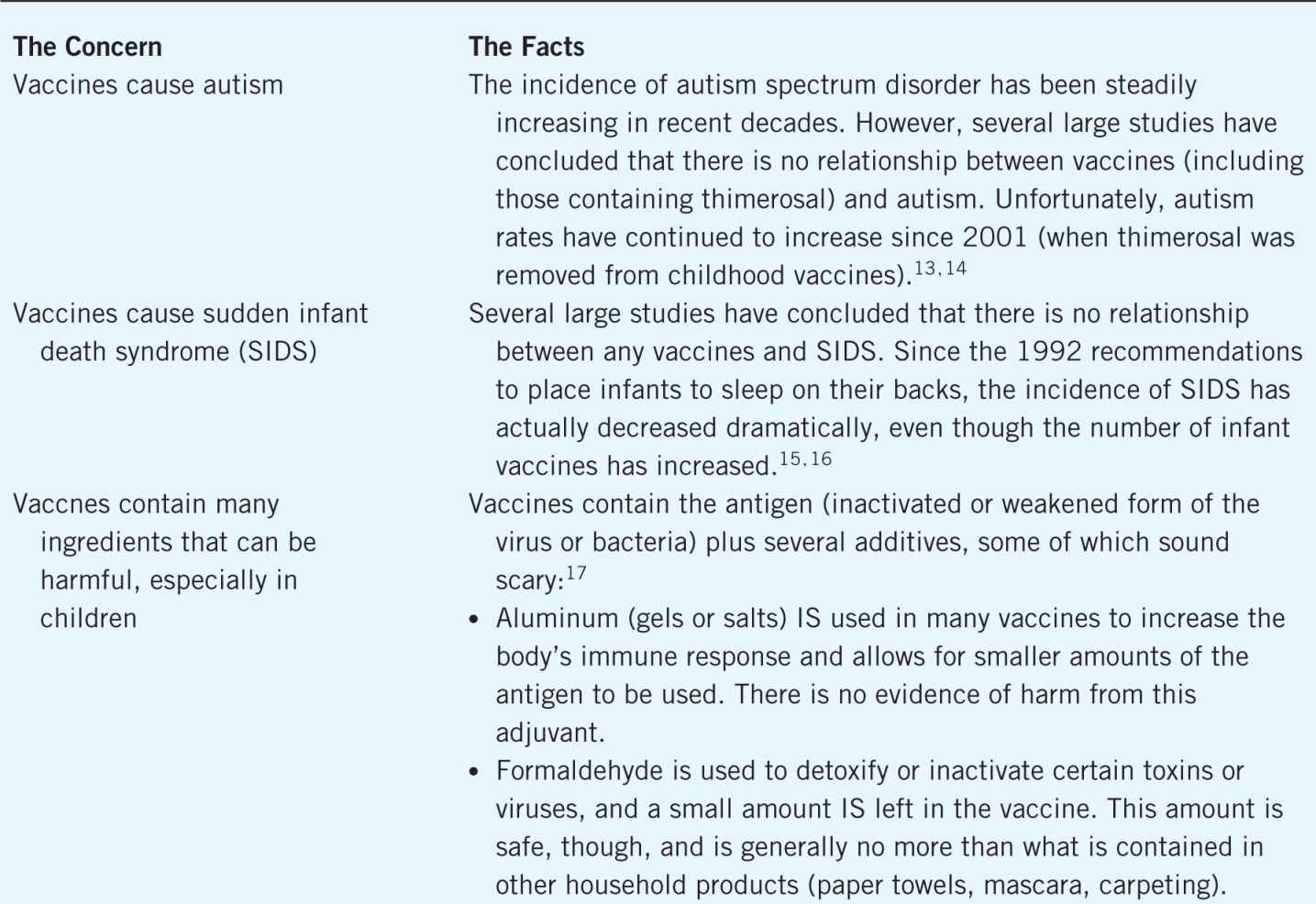![]() LEARNING OBJECTIVES
LEARNING OBJECTIVES
After reading this chapter, the pharmacy student, community practice resident, or pharmacist should be able to:
1. Describe the rationale for offering immunizations in a pharmacy setting.
2. Evaluate an individual patient’s need for vaccines, based on his or her specific history.
3. Analyze the business management aspects needed to create and maintain immunization services in a community pharmacy setting, including the initial development of the service, marketing, documentation, and reimbursement.
 INTRODUCTION
INTRODUCTION
The advent and routine administration of vaccines are perhaps the biggest advancement ever experienced in public health. In the 20th century, the average number of reported cases of measles in the United States exceeded 530,000 annually.1. This disease leads to many complications, including diarrhea, otitis media, and pneumonia. It can also result in encephalitis, seizures, and death in a small proportion of patients.2 The vaccine for measles was licensed in 1963. In 2010, there were 61 cases reported.1 Cases of mumps decreased from an annual average of over 162,000 cases through the 20th century to 2,528 in 2010. Similar decreases are seen in nearly all vaccine-preventable diseases after the advent of vaccines and widespread immunization. There were zero reported cases of smallpox, diphtheria, and paralytic polio in 2010. Newer vaccines have also led to significant decreases in annual cases since becoming routine. In comparison with the pre-vaccine era, varicella cases decreased by 89%, hepatitis B by 83%, hepatitis A by 91%, and invasive peumococcal disease in children (5 years of age) by 74% in 2008. Hospitalizations and ER visits due to rotavirus decreased by 88%, resulting in an estimated cost savings to the healthcare system of $278 million in 2008–2009 alone.3
Clearly, immunizations are vital for improving public health and decreasing healthcare costs. They work by provoking an immune response after vaccination similar to having the actual infection, and greatly minimize the possible complications.4 The different characteristics of vaccines (such as live versus inactivated, route of administration, and presence of adjuvant ingredients, to name a few) determine how they are used and dosed, but their underlying mechanisms are the same: provoke active immunity against the natural disease, allowing the recipient to fight it off when exposed later.
The details of vaccine science or all vaccine-preventable diseases are beyond the scope of this chapter. Rather, this chapter will focus on the pharmacist’s role in vaccine delivery and the establishment of a community pharmacy-based immunization service. There are many resources and references for more detailed information on the actual vaccines and diseases, some of which are listed at the end of the chapter.
Pharmacists and Immunizations
Pharmacists have served varying roles related to vaccines dating as far back as the 1800s.5 In 1993, DHHS officially recognized that pharmacists were able to assist in the areas of immunization education, distribution, access/administration, and registries/tracking systems. In 1994, the first organized formal immunization training for pharmacists took place in Seattle, Washington. A year later, about nine states allowed pharmacists to administer vaccines under a protocol or collaborative practice agreement. In 2006, that was up to 44 states6, and today pharmacists have the authority to administer vaccines in all 50 states and the District of Columbia.7 When pharmacists are in the role of vaccine administrator, the impact on vaccination rates has been shown to increase, although studies truly quantifying the impact are hard to conduct. Between 1995 and 1999, patients aged 65 years and greater living in states where pharmacists could provide vaccines had significantly higher rates of influenza vaccines than those living in states where pharmacists could not.8 One study of a large pharmacy database showed that high-risk patients receiving an influenza vaccine by a pharmacist were more likely to also receive their pneumococcal vaccine than in “usual care” settings.9
Even when not administering vaccines, pharmacists’ direct involvement in promoting immunizations has been proven beneficial. Patients encouraged in a mailing from their community pharmacist to be immunized were 74% more likely to do so than those who were not.10 Furthermore, influenza vaccination rates of high-risk patients nearly doubled when pharmacists in a rural clinic performed chart reviews and made recommendations regarding influenza vaccine.11 While the impact on vaccination rates has not been studied, 30% of pharmacists responding to a 2001 survey also reported facilitating nurse-administered vaccines in their community pharmacies.12 Pharmacists can also help to educate patients on the importance of receiving vaccinations and in dispelling many of the concerns surrounding vaccines that may dissuade people from getting them (Table 6–1).
Table 6–1. Common Concerns About Vaccines

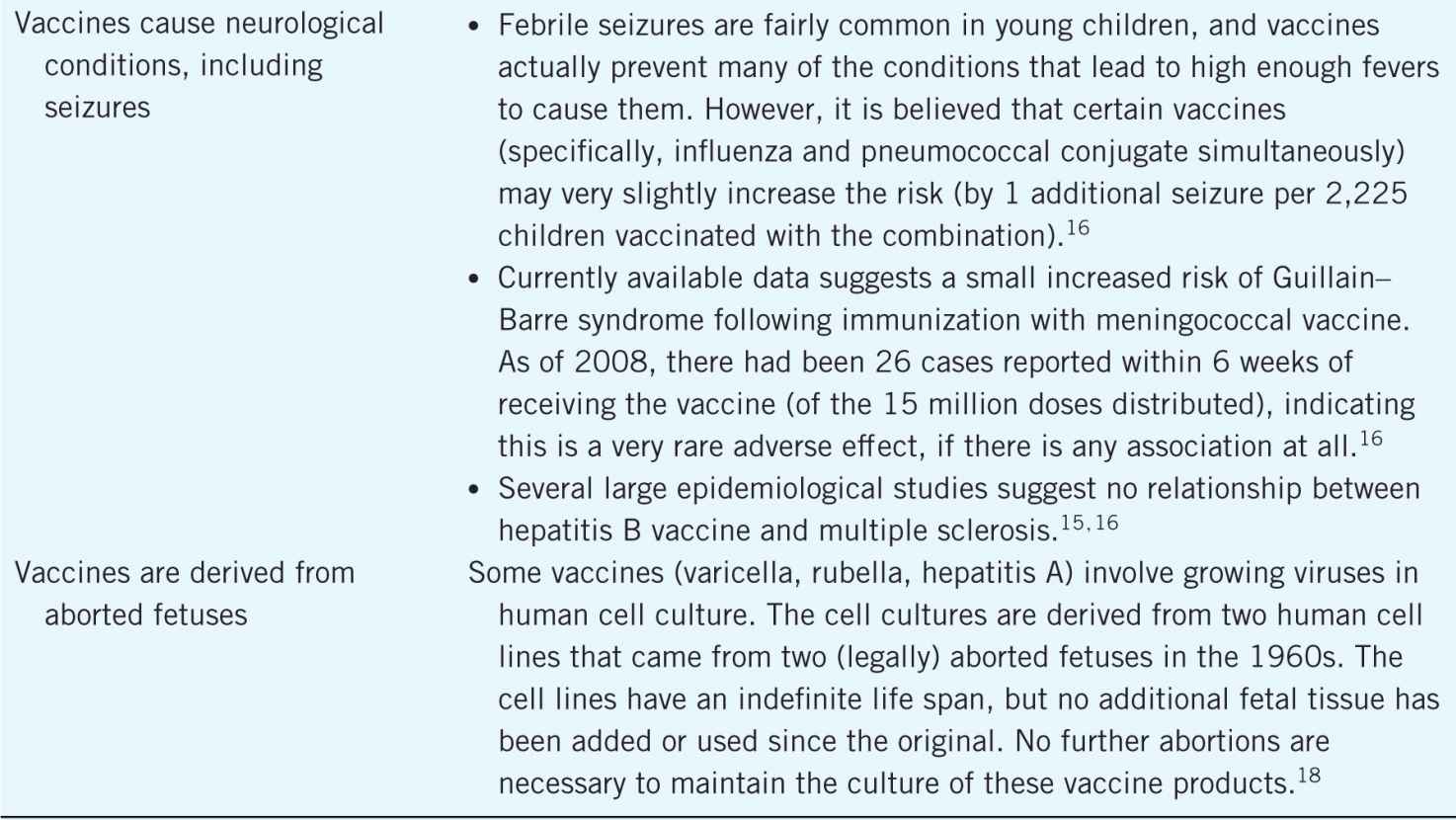
 VACCINE OVERVIEW
VACCINE OVERVIEW
Tables 6–2,6–3, and 6–4 contain information related to the specific vaccines that a pharmacist may be administering, and contains the information necessary to help a patient determine which vaccines they need. Note that the “Schedule” information assumes that they have not missed any doses and are currently on-schedule. If not, there are catch-up schedules available at the Centers for Disease Control and Prevention (CDC) Web site, to allow patients to get the optimal doses in minimal time. Also of importance is the fact that recommended vaccines schedules and indications are subject to change, so the official vaccine schedules should be consulted.
Table 6–2. Adult Immunizations19,20,21




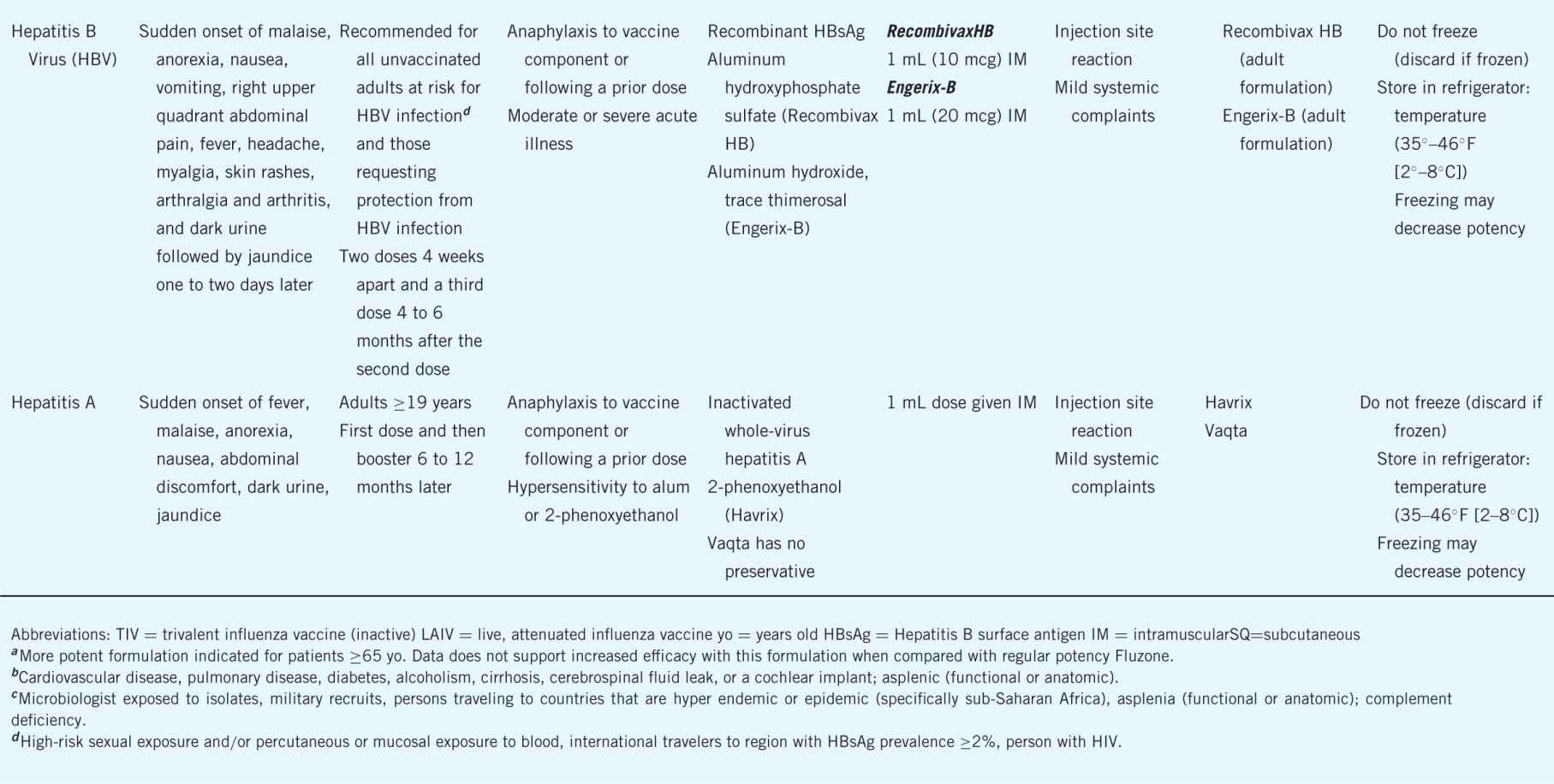
Table 6–3. Pediatric Immunizations19,20







Table 6–4. Travel Vaccines19–22



TIP: There are minimum intervals in between doses of most vaccines. Doses given inside of that interval do not count, and must be given again!
In order to know which vaccines a patient should receive, they must know what they have already had. Encourage patients to keep a vaccine record with them, especially if your state does not have a mandated central documentation database. If you are helping a patient determine what vaccines are needed and they do not have any record of receiving the vaccine (after checking multiple times), the rule of thumb is, “When in doubt, vaccinate.”
TIP: Live injectable vaccines must be separated from blood products (interval varies by type). Live vaccines (but NOT inactivated) must also be separated from each other by at least 28 days. However, they can be given simultaneously (on the same day).
 PLANNING YOUR SERVICE
PLANNING YOUR SERVICE
Legal Issues
Prior to developing an immunization service in the community pharmacy, it is imperative to research the current legislation in your state to determine what a pharmacist can and cannot offer, the requisite training and/or credentialing, what documentation is required, and how billing can occur. Many states allow pharmacists to administer any available vaccine, but only to adults, while others limit which vaccines can be offered. Some allow administration under a collaborative protocol, while others require an individual prescription for each vaccine administered. Table 6–5 reviews the laws regarding pharmacist administration of vaccines, by state. Please note that this table is current as of June 2012, and it is necessary for a pharmacist to confirm this information prior to offering vaccines.
Table 6–5. Vaccine Laws, by State23
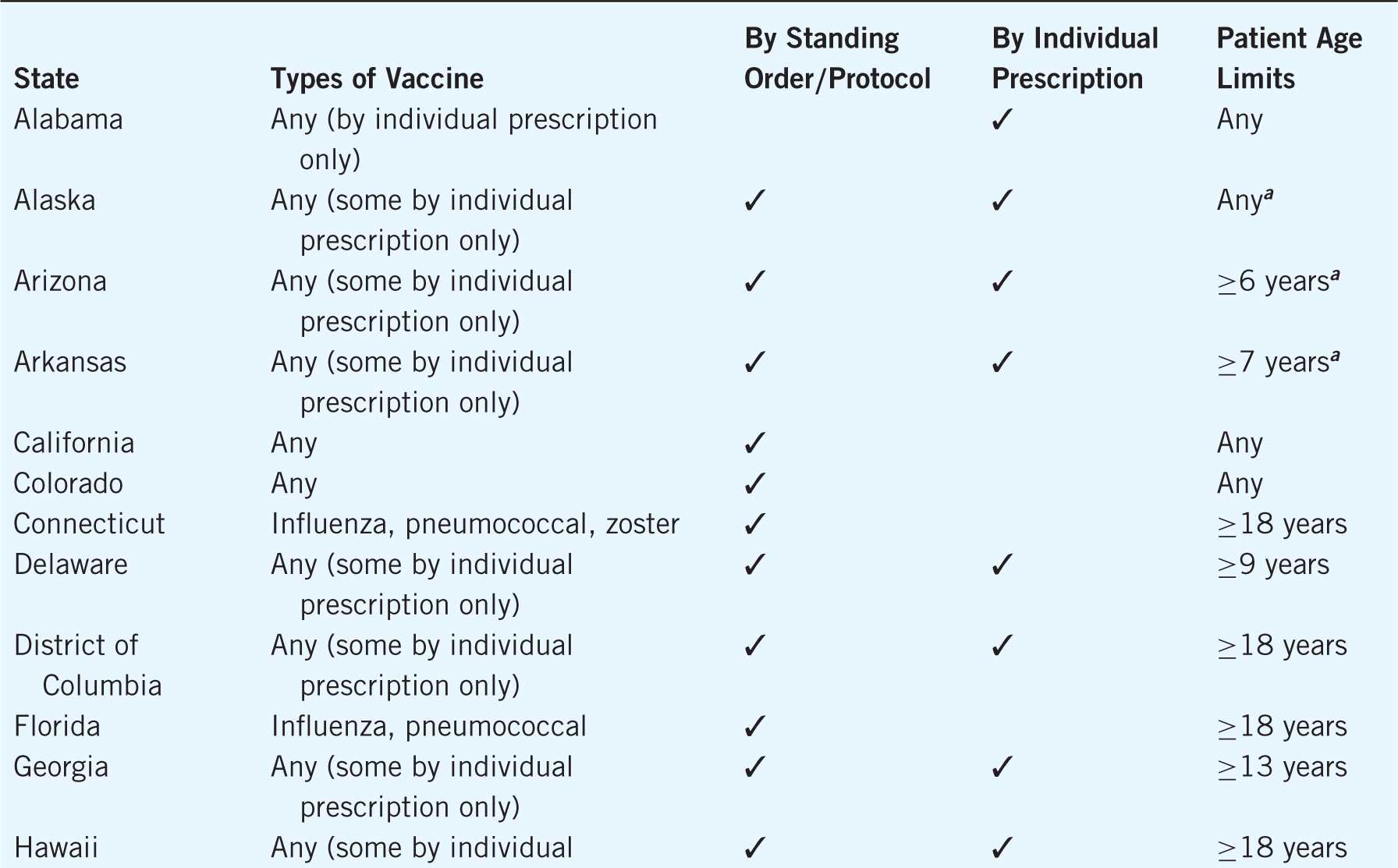
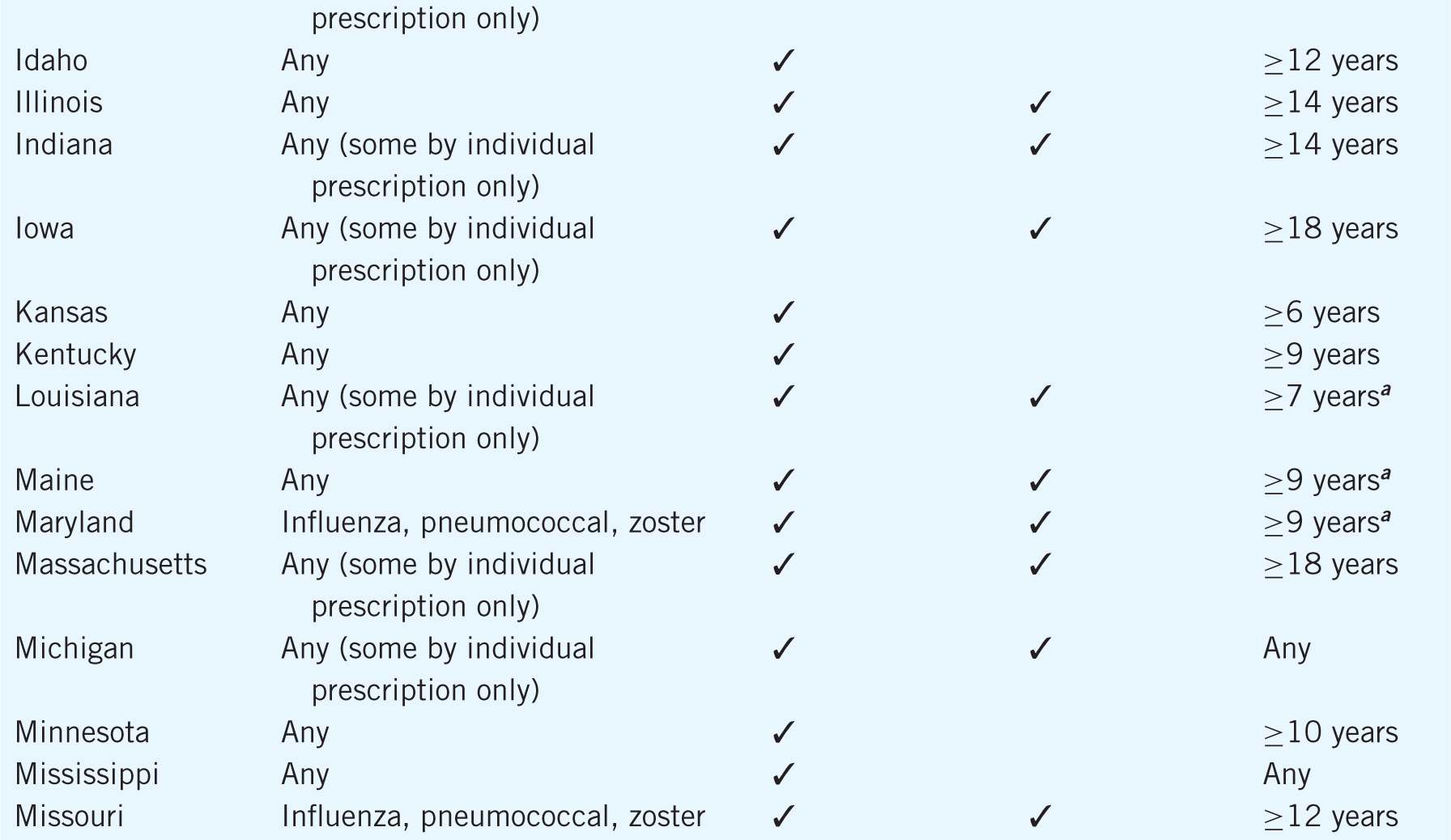


All immunizing pharmacists must receive Occupational Safety and Health Administration (OSHA) training prior to administering immunizations and update it every year. Employers must offer and document this training. You also must develop an exposure control plan, document the evaluation of which type of safety needle you will be using as you administer vaccines, keep a sharps injury log, and offer all employees who may come into contact with blood products hepatitis B vaccination AT NO CHARGE.
Any pharmacist involved in administering vaccines must ensure that his or her liability insurance specifically covers this activity. Many policies have nebulous wording, so a clarification may be necessary. Most companies offer “riders” to standard policies covering activities outside of the normal scope of practice, as they define it.
TIP: The time to purchase appropriate liability coverage is before the first vaccine is ever given, during the planning stages for the service.
Evaluate Facilities and Resources
A list of necessary resources for implementing an immunization service is included in Table 6–6. Staffing requirements will vary, depending on the type of flow that will be used (discussed below) and also which tasks can be performed by whom in your state. While space is obviously needed to implement immunization services, a complete renovation of pharmacy space is not necessary (although offering them in an office is a nice, professional touch). These services can be offered with as few changes as a portable partition and a chair in a corner, away from the general flow of the pharmacy business, or even off-site, with a rolling cart or other means or transporting supplies with you.
Table 6–6. Necessary Resources
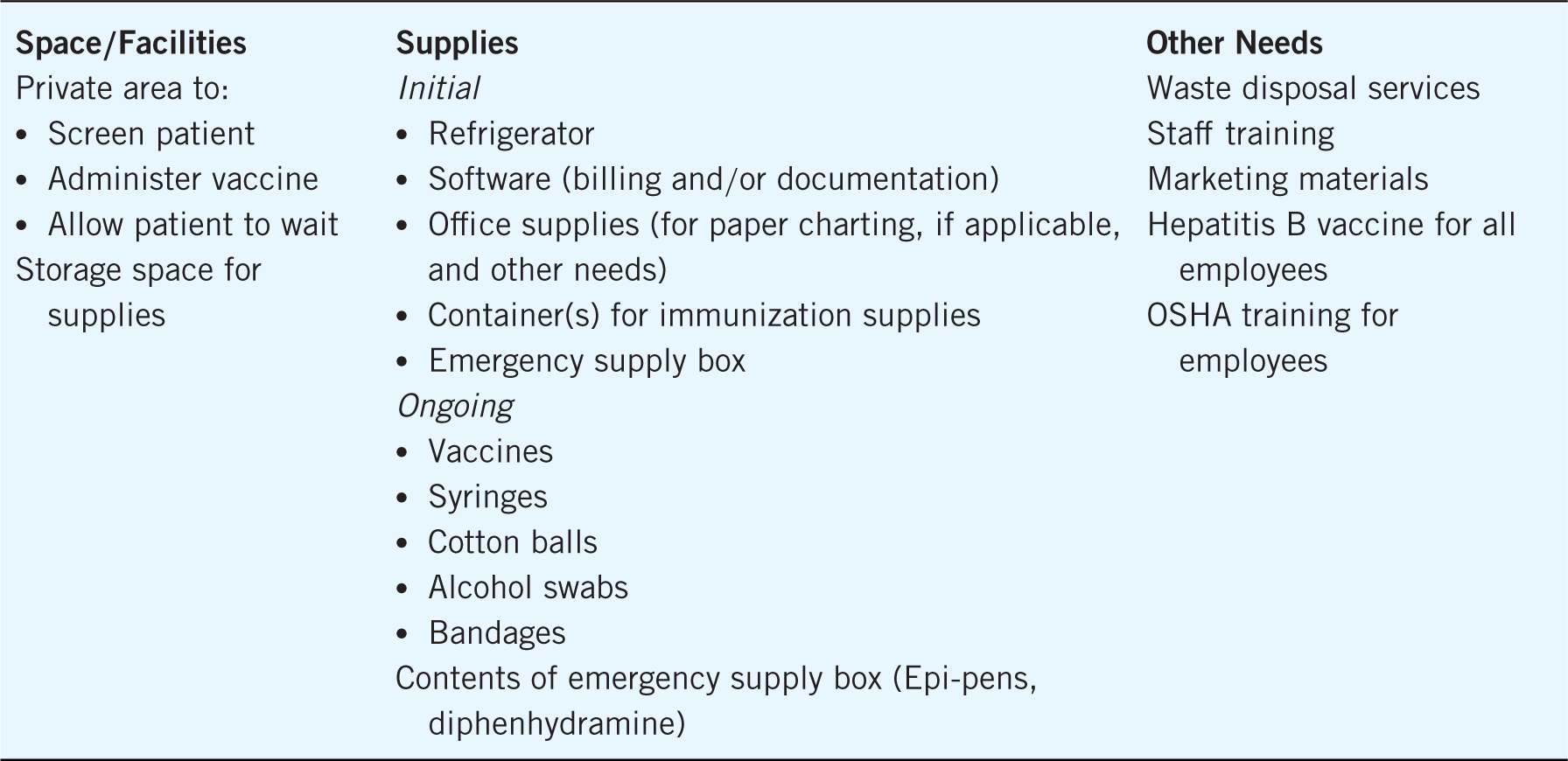
TIP: One individual should be responsible for a continuous inventory of vaccine product and other supplies, to ensure proper storage and that they do not run out.
Once the legality of pharmacist-administered vaccines for your state has been researched and a list of necessary resources compiled, the next step is to determine which vaccines should be offered. Many pharmacists choose to start their immunization practices by offering influenza vaccines. This is due to the need for annual vaccines for nearly all patients, the ability to identify many of those at highest risk from the disease by prescription records, the ability to bill Medicare Part B and other third parties, and the general acceptance of this limited role by other healthcare providers and patients. Should you choose to offer others, however, the choice of which one(s) will be based on several factors, including the needs of the patient population being served, the support from healthcare providers in the community, and the expected workload changes with the projected volume of vaccines offered. Of course, the immunizations offered can change as demand and pharmacist motivation change as well.
Current patients can provide information regarding which necessary vaccines they have not received, as well as their perceptions of the value of being able to obtain those vaccines in a pharmacy setting, or by a pharmacist in another less traditional setting, like the patient’s place of employment or another retail setting. Patient-specific factors such as age and socioeconomic status will play a large role in which vaccines you will offer. If your pharmacy serves a large proportion of senior citizens, then offering the pneumococcal polysaccharide vaccine (PPSV) would be a wise choice initially. If you are in a location that is near a college or university, focusing on vaccines that are often required for college admission, such as meningococcal or hepatitis B, may be a good place to start. If your patient base is made of affluent retirees, then perhaps offering travel vaccines would be a good choice.
TIP: To obtain information from patients regarding vaccines in the pharmacy, question those you know well, when they are not in a hurry and can take the time to discuss it with you at length, or develop a survey that patients can complete and drop in a box as they wait for their prescriptions to be prepared.
To determine the need for specific vaccines in your geographic area, it is also wise to talk with nearby healthcare providers. Healthcare providers in private practice, large healthcare systems, and at local public health institutions can tell you which vaccines they see “slipping through the cracks” in vulnerable patient populations. Are too few people receiving their boosters? Has there been an outbreak of hepatitis A recently? Are smokers receiving their pneumococcal vaccine? By approaching this from a, “How can we help?” standpoint and requesting the input of other healthcare providers, you may also be more likely to get their support and referrals as you begin to offer the vaccines in the pharmacy.
Determine Workflow
The legal requirements for pharmacist-administered immunizations and the resources available will, in part, dictate workflow, as will the type and anticipated number of immunizations offered. There are several options, with benefits and drawbacks to each one:
![]() Point-of-service. Patient requests one or more immunizations. That request is put into the prescription que, as if it were a new prescription to process. The patient is told how long they will have to wait, and the vaccine(s) is/are administered. The biggest benefit of this workflow includes minimal interruption to the normal procedure, and it works well when there is no extra or overlap pharmacist to assist in processing and administering the vaccine. It is also useful when the expected demand for immunizations is low, so that pharmacist time is not “dedicated” to only administering vaccines. In addition, it allows the technician to be involved in the “technical” aspects of the service (as allowed by state law): entering the prescription/order, drawing up the syringe, labeling appropriately, and collecting payment. The main drawback is that patients may not want to wait for the vaccine, especially if there is a long wait time. It also pulls pharmacists away from the normal workflow, so problems related to other prescriptions that arise may take longer to resolve.
Point-of-service. Patient requests one or more immunizations. That request is put into the prescription que, as if it were a new prescription to process. The patient is told how long they will have to wait, and the vaccine(s) is/are administered. The biggest benefit of this workflow includes minimal interruption to the normal procedure, and it works well when there is no extra or overlap pharmacist to assist in processing and administering the vaccine. It is also useful when the expected demand for immunizations is low, so that pharmacist time is not “dedicated” to only administering vaccines. In addition, it allows the technician to be involved in the “technical” aspects of the service (as allowed by state law): entering the prescription/order, drawing up the syringe, labeling appropriately, and collecting payment. The main drawback is that patients may not want to wait for the vaccine, especially if there is a long wait time. It also pulls pharmacists away from the normal workflow, so problems related to other prescriptions that arise may take longer to resolve.
![]() By appointment. Immunizations can be given on an appointment-only basis in most pharmacies. This will allow patients to be scheduled during times of lower prescription volume or when there are more personnel in the pharmacy. Whoever schedules the appointment can ask the general patient screening questions when the appointment is made, and document the responses. This also allows for adequate planning, so the prescription may be entered into the computer system (but not verified) and all other documentation (as discussed below) prepared prior to administering the vaccine. The downside is that this is not as convenient as a walk-in service for many patients, so could decrease the demand somewhat.
By appointment. Immunizations can be given on an appointment-only basis in most pharmacies. This will allow patients to be scheduled during times of lower prescription volume or when there are more personnel in the pharmacy. Whoever schedules the appointment can ask the general patient screening questions when the appointment is made, and document the responses. This also allows for adequate planning, so the prescription may be entered into the computer system (but not verified) and all other documentation (as discussed below) prepared prior to administering the vaccine. The downside is that this is not as convenient as a walk-in service for many patients, so could decrease the demand somewhat.
![]() Vaccine clinics. Dedicated blocks of time, possibly away from the actual pharmacy department, can be devoted to administering vaccines. This method is especially useful if a large number of patients are anticipated, such as during influenza season. It allows for adequate scheduling of staff for as short a time period as possible, so does not waste personnel resources. Vaccines can be prebatched (based on manufacturer’s recommendations), and technicians can, again, be involved in much of the process, allowing the pharmacist to administer many vaccines. However, a vaccine clinic is ideally scheduled during times of high traffic in the pharmacy, which may not always be the most convenient time for staff.
Vaccine clinics. Dedicated blocks of time, possibly away from the actual pharmacy department, can be devoted to administering vaccines. This method is especially useful if a large number of patients are anticipated, such as during influenza season. It allows for adequate scheduling of staff for as short a time period as possible, so does not waste personnel resources. Vaccines can be prebatched (based on manufacturer’s recommendations), and technicians can, again, be involved in much of the process, allowing the pharmacist to administer many vaccines. However, a vaccine clinic is ideally scheduled during times of high traffic in the pharmacy, which may not always be the most convenient time for staff.
![]() Off-site vaccine clinics. An alternative to vaccine clinics held within the physical pharmacy involves the pharmacist and possibly technician or clerk traveling to a place of business (banks, daycares, dental offices, insurance agencies, etc.) to administer immunizations to employees and family members at a predetermined time. Note that all documentation and safety requirements are the same, regardless of site.
Off-site vaccine clinics. An alternative to vaccine clinics held within the physical pharmacy involves the pharmacist and possibly technician or clerk traveling to a place of business (banks, daycares, dental offices, insurance agencies, etc.) to administer immunizations to employees and family members at a predetermined time. Note that all documentation and safety requirements are the same, regardless of site.
Develop a Business Plan
The purpose of any business plan is to encourage others to invest in your service. That investment may include money, time, and resources, or even professional trust. Whatever the purpose, a thorough and well-documented plan is essential. However, the focus may differ, depending on your intended audience. Standard components of a business plan may include:
![]() Executive summary
Executive summary
![]() Description of the business/setting
Description of the business/setting
![]() Type of pharmacy, physical structure/space, services offered, staff
Type of pharmacy, physical structure/space, services offered, staff
![]() Description of the proposed service
Description of the proposed service
Stay updated, free articles. Join our Telegram channel

Full access? Get Clinical Tree


